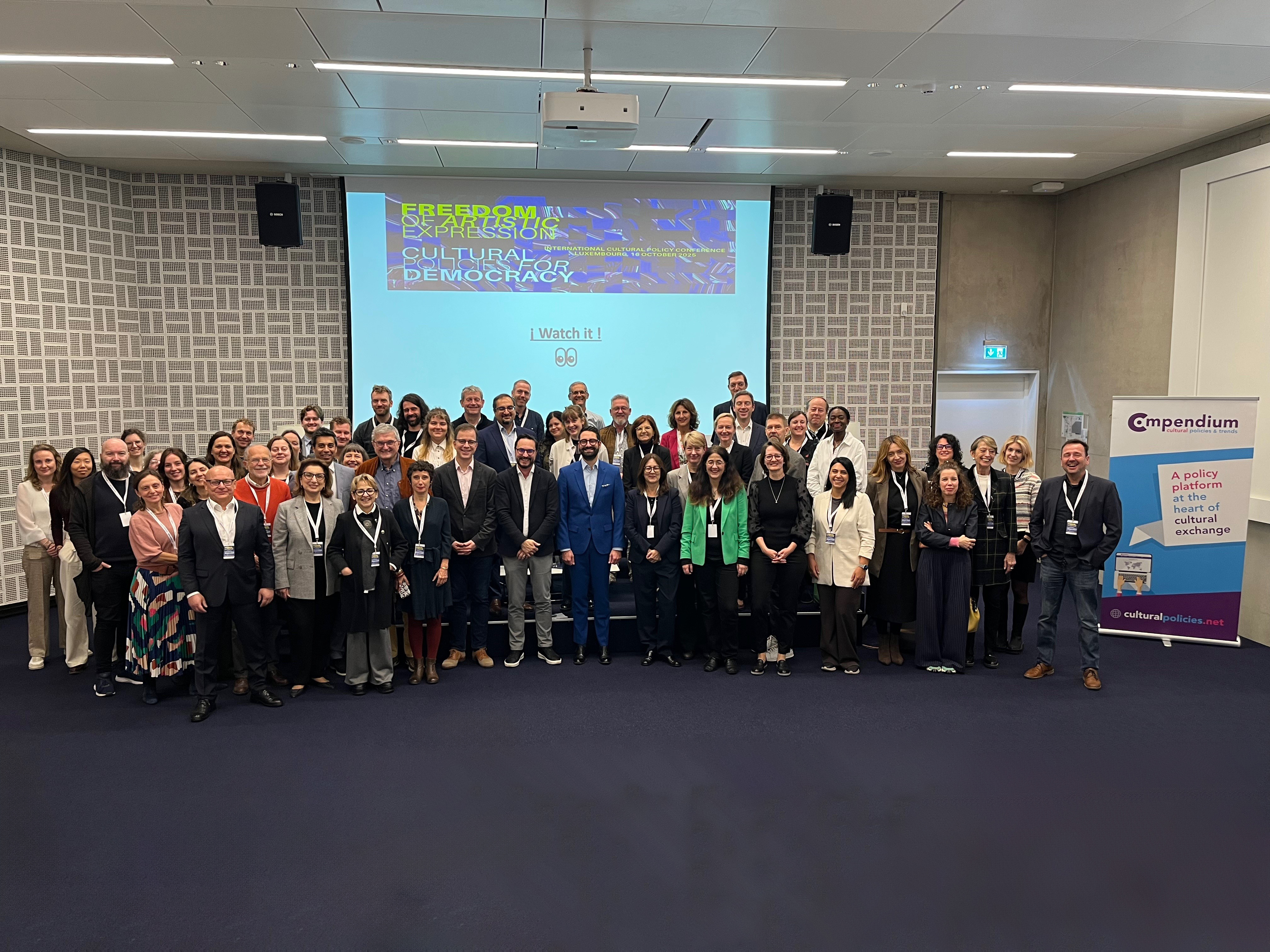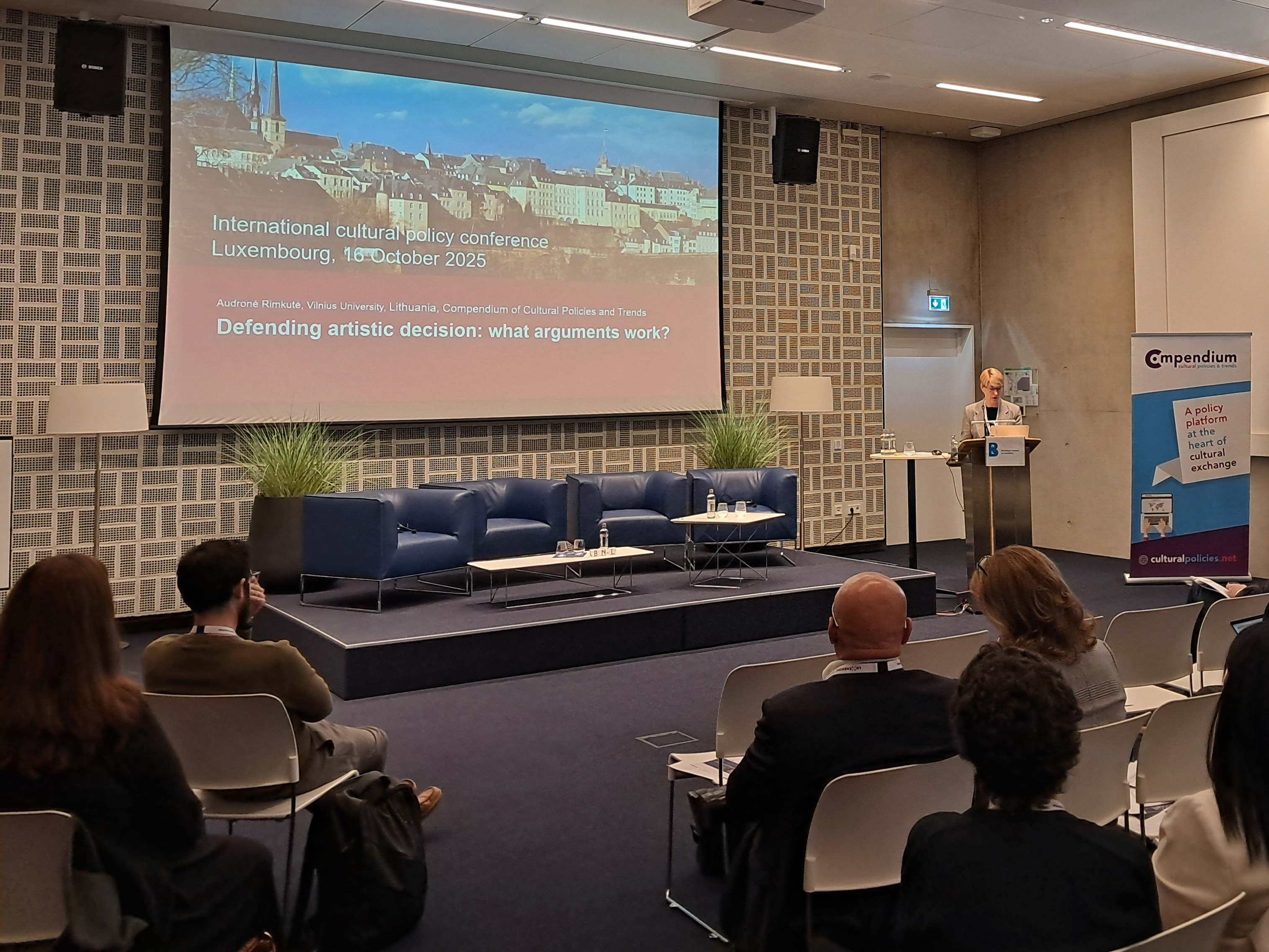 On October 16–17, the Chair of the Study programme committee of the Master's study programme Art Management at the Kaunas Faculty of Vilnius University (VU KnF), Assoc. Prof. Audronė Rimkutė participated in the meeting of members of the International Cultural Policy Network “Compendium of Cultural Policies & Trends” in Luxembourg and in the international conference “¡Watch it! – Freedom of Artistic Expression. Cultural Policies for Democracy”, organised by the Luxembourg Ministry of Culture and the National Library. In the first part of the conference, devoted to the analysis of freedom of artistic expression and its situation in European countries, the researcher delivered a paper entitled “Defending Artistic Decisions: What Arguments Work?”, in which she presented an overview of the situation of artistic freedom in Lithuania based on a qualitative case analysis.
On October 16–17, the Chair of the Study programme committee of the Master's study programme Art Management at the Kaunas Faculty of Vilnius University (VU KnF), Assoc. Prof. Audronė Rimkutė participated in the meeting of members of the International Cultural Policy Network “Compendium of Cultural Policies & Trends” in Luxembourg and in the international conference “¡Watch it! – Freedom of Artistic Expression. Cultural Policies for Democracy”, organised by the Luxembourg Ministry of Culture and the National Library. In the first part of the conference, devoted to the analysis of freedom of artistic expression and its situation in European countries, the researcher delivered a paper entitled “Defending Artistic Decisions: What Arguments Work?”, in which she presented an overview of the situation of artistic freedom in Lithuania based on a qualitative case analysis.
“At a time when democratic values are facing political, social, and cultural challenges, the organisers invited participants to rethink the role of cultural policy in protecting and promoting artistic freedom. Issues of legal protection, public attitudes, and the resilience of artists and cultural practitioners have become particularly important,” says A. Rimkutė.
She emphasised that artistic freedom is not the same as freedom of expression. UNESCO defines artistic freedom as the right “to imagine, create and distribute diverse cultural expressions free of governmental censorship, political interference or the pressures of non-state actors.” It encompasses the right of all citizens to access cultural works and is considered a necessary condition for the well-being of society. Artistic freedom protects not only the result of self-expression — an artistic work or text — but also the creative process itself, its conditions, and participation in cultural life. Its legal basis is Article 19 of the United Nations Universal Declaration of Human Rights, which enshrines freedom of expression, and Article 15 of the UN International Covenant on Economic, Social and Cultural Rights, which regulates cultural rights.
 “In my paper, I analysed public discussions arising from controversial works of art, as well as the development and outcome of such cases in Lithuania. We have more than one example, the most recent being M. Sauka's sculpture “Liudytoja” (Eng.: “Witness”) in Zarasai, which has been vandalised twice. My conclusion is that, although freedom of expression is legally protected in Lithuania, creators still suffer losses, including legal costs, delays in proceedings, declining audiences, and damage to their reputation. This shows that artistic freedom is not fully guaranteed,” explains the scientist. “From a philosophical perspective, freedom of expression is primarily associated with 'negative freedom' — freedom from unreasonable restrictions on the expression of ideas. However, it also requires positive guarantees, such as protection against violence for expressing one's views. Artistic freedom, in turn, encompasses both freedom from interference and positive freedom to act, i.e., real opportunities to create, rehearse, exhibit, distribute, and move around without discrimination. This understanding is precisely what is lacking in Lithuania.”
“In my paper, I analysed public discussions arising from controversial works of art, as well as the development and outcome of such cases in Lithuania. We have more than one example, the most recent being M. Sauka's sculpture “Liudytoja” (Eng.: “Witness”) in Zarasai, which has been vandalised twice. My conclusion is that, although freedom of expression is legally protected in Lithuania, creators still suffer losses, including legal costs, delays in proceedings, declining audiences, and damage to their reputation. This shows that artistic freedom is not fully guaranteed,” explains the scientist. “From a philosophical perspective, freedom of expression is primarily associated with 'negative freedom' — freedom from unreasonable restrictions on the expression of ideas. However, it also requires positive guarantees, such as protection against violence for expressing one's views. Artistic freedom, in turn, encompasses both freedom from interference and positive freedom to act, i.e., real opportunities to create, rehearse, exhibit, distribute, and move around without discrimination. This understanding is precisely what is lacking in Lithuania.”
Noteworthy lessons from Slovakia
The first part of the conference featured speakers from Germany, the US, and Slovakia. A. Rimkutė says that she was shocked by the report of Robert Spotak, the former head of the Slovak Arts Council, in which he revealed how quickly the Slovak cultural sector had lost its autonomy and creative freedom, and how the situation in Slovakia after the 2023 elections was similar to the one in Lithuania today.
“After the 2023 elections, the Slovak government was formed by a coalition of three political parties: Direction – Slovak Social Democracy (SMER-SSD), Voice – Social Democracy (HLAS), and the Slovak National Party (SNS). The coalition government led by Prime Minister Robert Fico took swift action to control artistic creation and reshape cultural institutions to conform to nationalist and conservative ideology. A key part of Fico's political strategy was to hand over control of the Ministry of Culture to the most radical right-wing party in the coalition, the SNS. Under the leadership of Martina Šimkovičová, a media figure with extreme right-wing views and no experience in cultural management, the Ministry has transformed from a supporter of cultural and artistic diversity into an instrument for promoting nationalist ideology. The actions taken by the new minister are symptomatic and could be alarming signals for all other countries aiming to protect cultural and artistic freedom, especially Lithuania. Hence, they are worth discussing in more detail,” says the researcher.
According to the researcher, cultural funding institutions (the Audiovisual Fund (AVF) and the Slovak Arts Council (FPU)) were taken over first, with changes made to the laws governing their activities. Legislative amendments increased the number of persons appointed by the minister to executive and supervisory positions, creating opportunities to exert political influence on funding decisions. The new financing decision-making procedure grants the government the right to veto recommendations made by expert committees. It enables it to block projects that do not align with the ruling party's ideology. Secondly, legislative amendments abolished transparency measures in the selection and dismissal processes for heads of cultural institutions, including public presentations by civil servants working in museums and galleries, as well as their protection against unfair dismissal. It became possible to dismiss directors without cause, thereby increasing political control over state museums and galleries. Then a mass "purge" of ministry employees was carried out. Almost 50% of the ministry's employees were dismissed suddenly and without explanation, and analytical and policy-making departments such as the Institute for Cultural Policy (IKP) were abolished. This eliminated evidence-based decision-making. Fourth, the heads of seven major national institutions were replaced, including the Slovak National Theatre, the Slovak National Gallery, and the Slovak National Museum. All these actions together create conditions for censorship and ideological control, encourage stagnation and conformism in the arts and culture sector, and thereby weaken democracy in the country, because culture is, first and foremost, a reflection of society and a catalyst for critical thinking.
Robert Spotak concluded his presentation with insights on how to avoid the situation observed in the Slovak cultural sector. Audronė Rimkutė identified recommendations that are relevant to Lithuania: “First and foremost, umbrella cultural organisations need to be created that would encourage people to immediately stand up for institutions and principles that radical parties are targeting. Second, cultural autonomy and self-government must be maximised and consolidated through legislation. Third, as many expert institutions as possible should be established, and their recommendations should be relied upon in cultural management. Fourth, a system of private cultural funding that encourages sponsorship and patronage needs to be developed and expanded. Fifth, sources of cultural funding in the regions need to be created. Sixth, it is necessary to work with different audiences and involve as many people as possible in cultural development.”
Good practices encourage a paradigm shift in cultural policy
The second part of the conference, “Supporting Freedom of Artistic Expression Before it Needs to be Defended”, was devoted to discussing best practices in defending artistic freedom. They can serve as examples for other countries, including Lithuania. The most advanced cultural rights plan in Europe, the Spanish cultural rights plan, was presented by Professor Anna Villarroya of the University of Barcelona. The plan is impressive in its ambition and scope. Its essence is to change the paradigm of cultural policy and move from the logics of ‘accessibility’ or ‘entertainment’ to the concept of culture as a fundamental human right.
“The plan recognises culture as a fundamental right and a common good linked to prosperity, democracy, and social justice, proposing a paradigm shift that emphasises the active role of culture in social change and the strengthening of a more just and participatory democracy,” says Audronė Rimkutė. She also mentioned that the plan includes a total of 146 measures to be enforced between 2025 and 2030, with €79 million allocated for its implementation.
Audronė Rimkutė mentioned a report by French scholar Jean-Cédric Delvainquière as particularly relevant to the defence of artistic freedom. He presented the French Ministry of Culture's Artistic Freedom Plan and the Legal and Practical Guide to Artistic Freedom.
“The plan consists of three parts: monitoring and responding to artistic freedom, for which a special officer and advisors have been appointed in each regional cultural affairs directorate of the Ministry of Culture; providing information and assistance to artists and cultural professionals; involving all stakeholders in inter-institutional dialogue. One of the measures in the second part of the plan is the Guide to Artistic Freedom. This 128-page document explains the principles and foundations of artistic freedom, providing 22 sets of practical advice along with a selection of case law and contacts,” explains the scientist. She noted that such a guide is handy in various cases of violations of artistic freedom —it advises artists and arts organisations on how to respond when faced with the blocking and disruption of events, damage to works, defamation, and cyberbullying.
“It is essential for Lithuania to have such a publication and, in general, a plan for defending artistic freedom,” Audronė Rimkutė is convinced.